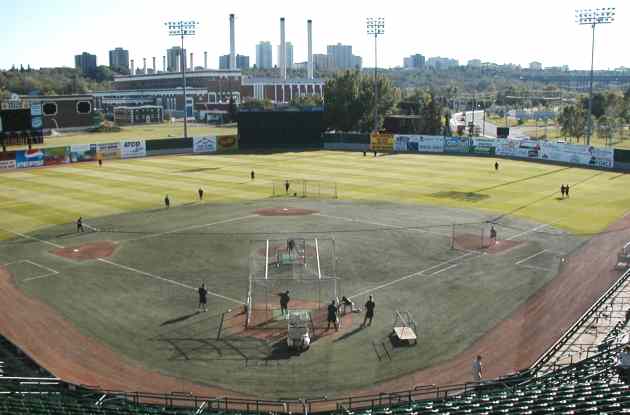
 Telus Field for Baseball
Telus Field for Baseball

Field Details
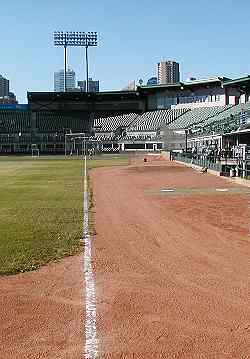
| Left | Left Center |
Center | Right Center |
Right |
|---|---|---|---|---|
| 340 | 378 | 420 | 395 | 320 |
Dugouts & Bullpens
- Cracker-Cats are on the third base side
- Opponents on first base
- Dugouts are slightly below ground and somewhat further down the line than normal
- Bullpens are down the line and in play
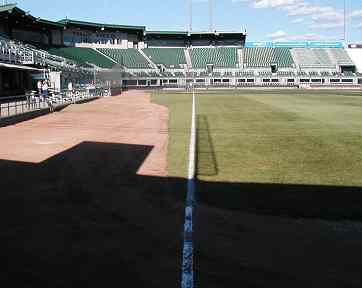
Fences & Field
- Three Words: "artificial turf infield"
- Fences are 12' tall around entire field (except:)
- Batter's eye stands a tall 34' in center
Webmaster's game assessment
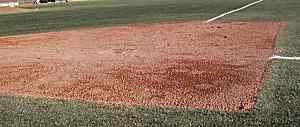
The Artificial Turf Infield
When it comes to actually playing baseball at Telus Field one thing stands out immediately: the infield. Telus Field has always had an artificial turf infield. The reason for this is (was) simple when the ballpark was being built. Some MLB teams wanted their prospects and players to get experience playing on the same sort of field they would find in their home field. Other suggestions are that infield grass is hard to maintain in the Great White North (dubious and probably wrong) or it would allow the field to be used for other purposes without damage (such as concerts).
Regardless of the reason, the turf area itself covers the entire infield from the infield warning track to beyond all the bases. Each base has a dirt cutout with turf in between the bases themselves. The turf then extends to what would normally be the dirt of the basepaths.
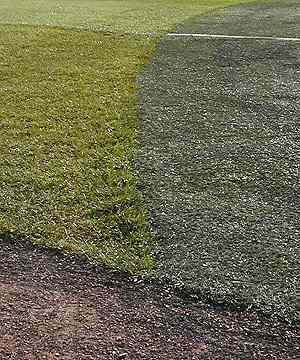
Today, for the Northern League, it makes little sense at all. Except for the years when the Goldeyes played at Deformity Field, no NoL team has had artificial turf of any kind. What's all the more frustrating for baseball purists (and others) is that for 2005 the old "astroturf" was replaced with new "field turf." The seam is fairly noticeable between the dark green infield and the lighter (yellow-) green of the real grass.
One would have thought that it the change of leagues might allow this abnormality to be eliminated. The fact may simply be that it probably isn't all that simple. The infield is (almost certainly) on concrete to support the turf (old or new) or simply does not have the necessary drainage and/or irrigation. As a result replacing it with grass would be a much larger cost than it appears. Regardless of the cost, it was the decision of the City of Edmonton and not the Cracker-Cats.
The "good news" about the infield is that it was installed well for 2005. The "seam" between the surfaces is quite level so there is less change of unusual bounces. The dirt "cut outs" are also level and well maintained. The grounds crew seems to be well aware of what is needed to minimize what otherwise might become a major criticism beyond the makeup of the field itself.

The field turf is considerably more "natural" feeling than astroturf (essentialy the difference between playing on plastic fibers of an artificial Christmas tree and indoor outdoor carpeting). Still it feels somewhat slippery and by its very nature plays much faster than grass. It also leads to questions about what footwear infielders should wear (if they have options).
Extra High Batter's Eye
After you get over the choice of infield surface you may notice another "special feature" of Telus Field: The "extra high" batter's eye. Most of the outfield fence is 12' high. The batter's eye is 34' and in play. The result is a "green monster" that devours nearly all towering or line drive "home runs" and turns them into doubles. The history of Telus Field has had very, very few hitters who have been able to clear it. Local baseball fans can tell you who.
General Characteristics
As for the field for normal play, the other obvious issue is the orientation of the field to the southwest. The result is that the sun in is the batter's (and catcher's) eyes during afternoon games. Sunset may put the sun into the third baseman's eyes depending on the shadows of the dome of the legislature building.
Another characteristic of the ballpark is that not far beyond the right field fence is Rossdale Rd NW. In this Telus Field has another characteristic that was seen in Winnipeg in year's past: some home runs or line drive fouls may hit the passing traffic on the road. Unlike the temporary solution at the Fish Bowl (where large, tall nets were installed to protect passersby prior to the stadium expansion of 2003), drivers take the route go past the ballpark at their own risk.
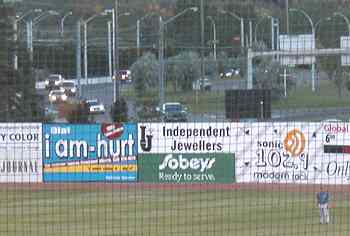
To be fair, unlike Winnipeg where the foul pole was literally almost on the sidewalk by Pioneer Blvd., nearest edge of the street is 10-30 ft beyond the right field fence. But it is only 320' down the first base line so, fans in the upper seats may become witnesses to the occasional "baseball sized hail" hitting passing traffic.
As mentioned elsewhere the other differences are relatively minor. In providing ground level suites the dugouts were moved further out nearly into the outfield. This means players and coachs on the bench are further from home plate and less able to see the action there than at most ballparks. While that may be considered a negative, it also puts the dugouts closer to the bullpens which may help in checking the condition of relievers.